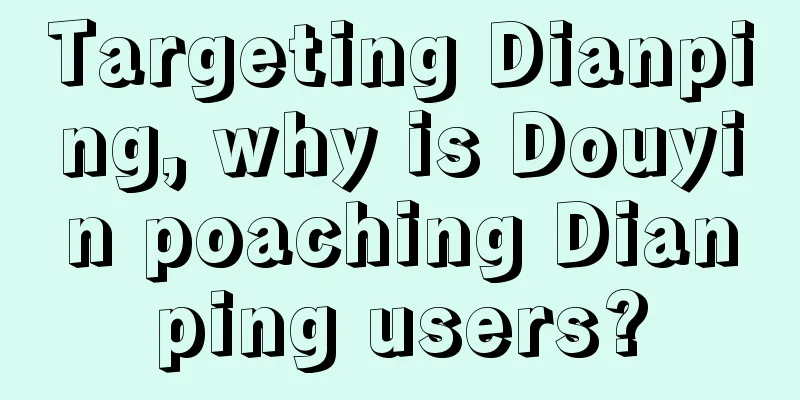Private Domain Sharing | This article tells you what is behind the traffic?

The term "private domain" is becoming more and more popular. After the 1.0 extensive era, more and more companies have been laying out their own private domain assets. In the face of the current era of full-staff refinement, as an ordinary operation worker, what kind of basic capabilities should you master when facing the private domain to gain the appreciation of your leaders? This article will start from the basic understanding of private domain drainage to understand in detail what kind of work needs to be done behind a successful drainage plan. 1. Why do we need to attract traffic?At present, the advertising costs of major platforms will only go higher and higher. In order to acquire customers, small and medium-sized enterprises can only pay for the price increase of large platforms. As a result, the traffic pool is shrinking and the price of paid traffic is getting higher and higher. Through communication with many ordinary operation friends and some of my actual work records, I found that most people regard private domain as a simple addition to WeChat and group. If you think that traffic generation is simple, I can only say that you are still too naive to think about traffic generation. Here I have summarized two typical situations 👇, which are problems that I and most of my friends have encountered. You can also recall whether you have encountered such problems.
In the above case, the leadership lacks the understanding of traffic diversion and unilaterally believes that the number of users is the whole of the private domain. This cognitive deviation leads to the tasks assigned to grassroots employees deviating from the normal private domain operation assessment. The result is often failure. In addition to this type, there is also the following situation, which is also one of the misunderstandings I have made.
We will find that most people now still follow the above situation, but they don't know the logic behind this IP. The reason for this misunderstanding may be that the team leader did not tell you why you did it, resulting in no improvement in performance after you executed it, or it may be that the methodology you saw is indeed not applicable to your industry. It can be said that such a situation still does not have a thorough understanding of drainage. Then again, how should we drain traffic? This must first be linked to the big topic of private domain. 2. How to conduct drainageMany articles and books have explained the private domain in great detail. The more official one is that the private domain refers to a field where brands can reach users in a repeatable, low-cost or even free manner. The private domain format is an integrated online and offline brand independent business position. It is also a new format for brands to develop independently, fully grasp customer relationships, and link online and offline. It's a bit difficult to understand, right? Then we can also understand that the private domain is a low-cost, reusable channel. At the same time, the private domain is also a business behavior. It allows companies to maintain a relatively long-term and loyal relationship with customers, so that customers will not be affected by other competing products. Here you can see that I regard the private domain as a business behavior, and I am more concerned about the transaction. Some friends may think when they see this, isn't the transaction just about conversion? What does it have to do with drainage? As long as you add people, send more advertisements, and optimize the copywriting, won't everything be fine? This idea is actually half right. Adding people to WeChat and repeatedly exposing products to customers does use the private domain as a low-cost, reusable channel, but it focuses more on the company's "self-entertainment" and does not care about the customer's feelings. Without the customer, it is not a long-term relationship, let alone loyalty. It's like a relationship. The boy/girl who pursues you will only express his/her own opinions and ignore all your feelings. Therefore, from the first step, we should pave the way for transaction conversion. The first step of private domain operation is to attract traffic. I guess you must be thinking now, I will definitely talk about how to generate traffic next. Don’t worry! Compared to knowing how to do it, I recommend thinking about the definition of traffic generation first. Direct Baidu traffic diversion, one of its definitions is to use some methods to guide something to the place you point to. In other words that operations can understand, private domain diversion refers to the process of guiding target users from one place to the company's own traffic pool using some methods, which can settle down. It is also the first step of private domain operations. Therefore, I think that traffic generation should be a process, not a single method. The two problems mentioned above only use one business step in traffic generation, which is limited. The entire process should be used to lay out the traffic generation plan, so as to effectively improve performance. So how do you make a reasonable drainage plan? There are only three steps: open source, reservoir, and drainage. 2.1 Open SourceThe first is open source, which means understanding the value of your product and the appropriate business model. In other words, when you go out and make new friends, you need to know what kind of person you are so that you can know what kind of friends you want to make. The purpose of doing so actually corresponds to what was mentioned at the beginning: the traffic pool is shrinking, and the price of paid traffic is getting higher and higher. So how can we magnify the advantages of our own products in a limited space? It also depends on how well you understand your own company's products. During the open source stage, I suggest that you focus on two aspects: products and company business. Why do we need to think about these two issues when attracting traffic? First, for a company, the product is 1 and marketing is 0. The value of the product determines why users choose you when attracting traffic in the private domain. If a business closed loop is not formed, then no matter how well you do the traffic attraction, if you find that there is no suitable product, you will only waste the traffic at hand. The second is for individuals. As ordinary workers, starting from the overall situation, we can break away from the constraints of leaders, stand at a higher angle to see the overall business picture, find the problems of the current project, and then break down the problems and solve them one by one. It is very rare for ordinary people to encounter 0-1 projects. Even if it is a 0-1 project, it is necessary to think about the overall situation from the product and company business. These two considerations can actually be solved with a tool, the business model canvas. After filling in the 9 components on the business model canvas, you can have a global understanding of the business. The nine elements are customer segmentation, value proposition (difference point), channel access, customer relationship, revenue source, core resources, key business, important cooperation and cost structure. Let's dig a pit here first, and then discuss with you how to use this business model canvas simply and quickly. Business Model Canvas 2.2 Renovation of water tankAfter thinking about the underlying logic, the next step is to start digging the reservoir. The main line of this step is to revolve around IP. Now the mainstream venue for private domain IP is WeChat/Enterprise WeChat. This is equivalent to how the host should receive friends who come into our house. I have said before that private domain is a kind of business behavior that has long-term customer relationships and is not easily affected by competing products. So all scenarios that can maintain customer relationships can be considered private domains. In general, the private domain reservoir is mainly based on the WeChat ecosystem, including WeChat, corporate WeChat, communities, public accounts, mini programs, video accounts, etc.; in particular, only personal WeChat/corporate WeChat friends can be considered private domains. Why do I say that? Because in the WeChat ecosystem, WeChat is always the app that users use the longest on their phones, especially since the infrastructure of the WeChat ecosystem is the most complete (social relationships, group chats, live broadcasts, etc.). Compared with using TikTok and WeChat at the same time, users are most likely to receive your messages first on WeChat. So the reservoir here is mainly WeChat as an example. By building a good IP through WeChat, the value of the product can be deepened in the eyes of users, and it can also further replace the competing products in the minds of customers. For companies, they can create brand-based IPs. Just like Perfect Diary's "Xiao Wanzi" and Keqila's "Qige", the company can easily control the IP, and the conversion rate will not be affected by personnel changes. After all, who is "Xiao Wanzi" has little impact on the brand. Then again, how should this reservoir be built? Starting from two aspects, do a good job in private domain IP positioning and acceptance. Positioning is to make a skeleton for the IP, and acceptance is to make the IP look more vivid. Regarding the issues mentioned before, there are many methodologies on how to create IP. Here I will summarize the common methodologies. First of all, it is about positioning. The core is vertical character setting and diversified content. How to understand this? Character setting is your identity, and content is your external expression. Just like the character setting of "Xiao Wanzi" of Perfect Diary is an exclusive welfare officer, so the corresponding thing is that you will be sent brand-related welfare activities. Looking back, let's look at the content presentation of "Xiao Wanzi". Taking the circle of friends as an example, there are new products, reviews, and daily life and interactions. This is diversified content. In this regard, our most important work is to focus on the business canvas that we have already understood, find our target customer base, and find the products and values that can be provided to customers, and explore a suitable positioning for our brand through three prongs. Of course, it is recommended that IP be presented in real people if possible, because fictional people may seem safe on the surface, but in fact, the relationship between them and customers is severed. From my personal experience, the IP currently in operation is a cartoon character. Because it is fictional, it is easy for users to call it a robot. This kind of "misunderstanding" happens many times and is not conducive to later conversions. Next is the issue of traffic flow, the purpose of which is to make customers remember you in the shortest possible time. In terms of traffic flow, we need to focus on three points, namely name, self-introduction, and self-label. For cold-start small IPs, the formula of IP+function+feature can be considered for naming, such as Handmade Geng, Luxury Car Poison Lao Ji, Private Domain Xiao Changzhang. For brand IPs, the model of brand+function+IP can be considered, such as Adopt a Cow Nutritionist and Drunk Goose Lady’s IP “E Niang”. After choosing a name, we should not just wait for traffic to arrive, but also make adequate preparations to welcome customers. At this time, we should prepare an easy-to-remember self-introduction welcome message to show who I am and my role. For example, Zui'e Niang's welcome message begins with an introduction of herself: "I am your Goose Niang, your exclusive service staff"; Keqila's IP Qi Ge will introduce herself as an exclusive welfare officer; Yuanqi Forest's welfare figure Xiao Yuanzi will also name himself as a welfare officer in the welcome message. Finally, label yourself. Doing this is actually to make your IP more complete and become a memorable person. Maybe you think it is unnecessary, so I will give you an analogy and you will understand. Imagine that when you go for an interview, the interviewer looks at you based on these aspects: who you are, what you look like, what you say, and what you do. Users see you in much the same way. Therefore, in order to create such an image, we can label ourselves based on our profession, image, language system, and behavior. So how should this be posted? In terms of professionalism, you can emphasize your own value more, such as "your skin care consultant", "exclusive welfare officer", "sharing private domain information on WeChat Moments every day", etc., and use future value to highlight your own value. In terms of image, we must make full use of our WeChat and use avatars, personal signatures, circle of friends backgrounds, etc. These basic interfaces are all good media as memory points in the minds of customers. If you want to make it more beautiful, you can communicate more with your own design managers. The core goal is to make customers remember you. For the language system, you can use more golden sentences and tell more stories to deepen the memory points. Behavior corresponds to what you have done, and you can use your social network to highlight it. Birds of a feather flock together. What kind of person you are, your friends are also like you. In addition to this, you can also use emotions and meaningful things to assist. Over time, your IP will become fuller. 2.3 Traffic diversionFinally, we have reached the final stage of drainage. Do you remember what I meant by drainage before? Private domain traffic diversion refers to the process of guiding target users from one place into the company's own traffic pool and allowing them to settle down using certain methods. If the previous steps of open source and reservoir are to find target customers and prepare for customers to settle down, then the most important step of the drainage stage is what method to use to guide. Many operators know that traffic can be fished from large platforms, but this is only a small part of the traffic, just like a small school of fish in the sea. We further subdivide the traffic into external traffic and internal traffic. In addition to the public domain of the large platforms mentioned above, external traffic also includes other people’s private domains. Internal traffic refers to the traffic you already have. Therefore, traffic acquisition is not a single process, but a multi-faceted plan. Traffic diversion can be divided into two modules: external and internal. The scenarios of external traffic include public domain algorithm recommendation, public domain paid traffic purchase and exchange with others' private domain; the scenarios of internal traffic include self-owned traffic interception and self-owned private domain fission. These five scenarios have corresponding underlying methodologies. Let me explain them one by one. The first is public domain algorithm recommendation. Back to our public domain algorithm recommendation, many friends' first thought of traffic diversion is to choose Douyin, Xiaohongshu, Bilibili, Zhihu...these content platforms to start diversion. There is nothing wrong with this method, but one thing needs to be noted, the traffic distribution mechanism of these content platforms is gradually becoming "algorithm recommendation". This change allows the platform to firmly grasp the right to distribute traffic. On the surface, we acquire customers on the platform through our own content, but in essence, the platform turns us into free workers to retain customers. In order to avoid such "freeloading", we have two ways to deal with it. First, we try to understand the algorithm recommendation mechanism of the platform as much as possible, select industry benchmark accounts, and select accounts with a certain number of fans to learn and disassemble, and make full use of the exposure on the platform. Second, regardless of whether the content is popular or not, we try to guide users to join the private domain, but the platform does not want you to do this, so you can design hooks on the homepage, content, and comments to let users contact you and add your WeChat. After having a general understanding of the public domain algorithm, we switch to the scenario of buying traffic in the public domain. Most content platforms will provide creators with official tools for buying traffic, such as Taobao's "Direct Train", Douyin's "DOU+", and Kuaishou's "Fentiao". We can make full use of these official tools, such as testing content data, cold starting accounts, etc. If you want to divert traffic to WeChat, you can design a hook, buy traffic to heat up the video, guide customers to reply to private messages, and then guide them to WeChat. This is also a better method. If there is good content, good hooks, and good execution, this is a relatively stable way to divert traffic. Next is the last public domain scenario, other people’s private domain. Other people’s private domain is actually our public domain. You can talk to the person in charge of other people’s private domain by changing groups and volume, but you must prepare the corresponding content and hooks. If you think that external traffic diversion is too difficult to understand, you can change your mindset and consider internal traffic first. The difference between own traffic interception and own traffic fission is that interception focuses on adding accessible traffic to the private domain, while fission focuses on how customers who are already in the private domain invite others to the private domain to get to know you. Let's first look at the internal scenario of own traffic interception. Own traffic is a diversified scenario. Depending on the product, the strategy of designing the WeChat hook is also different. But there is no connection at all. In summary, there are three common ones, namely stores, e-commerce, and education. For stores, they often give away some physical goods as a strategy to attract customers to the private domain. For example, Xibei, a common way is to add the store manager's WeChat to get a new product/hot-selling product, usually lamb skewers. Some store merchants also choose to add WeChat discounts. Therefore, there are still many ways to accumulate traffic in store scenarios. Such methods only require a small cost to accumulate store users. For e-commerce, a common practice is to send red envelopes with parcel cards. This is also aimed at paying users. Take Perfect Diary as an example. After users purchase products, the welfare card attached to the package will show the customer's winning welfare in the form of scratching, and then guide customers to scan the code to add "Xiao Wanzi" to receive it. Of course, after receiving the welfare, "Xiao Wanzi" will also take the opportunity to invite you to join the community and follow the video account to increase the brand's presence. Next is education. Most education and training companies will set up a diversion entrance through their official website homepage, and guide users to add teaching assistants on WeChat by giving away courses, materials, and useful information. The methods corresponding to the above three scenarios are all relatively common solutions for traffic generation, but don’t forget the product and business thinking you have done before. When using them, you should adjust them according to your company’s situation. The final way to obtain internal traffic is fission. In recent years, there are many fission methodologies. Here are three interesting ideas for reference: recognition, delivery, and benefits. The first is recognition, which is applicable to some content IPs. By outputting content, you gain recognition from others and get recommendations from others through this recognition. The second is delivery, which refers to product delivery. As mentioned before, product is 1 and marketing is 0. No matter how good the marketing is, it is better than the delivery of a good product. The last is the relatively large interest bundling, which is also the highest level of fission. Representative practices include direct commissions or allowing customers to obtain agency qualifications. However, this mechanism can only be generated under the premise of a certain scale and product delivery. These three interesting ideas are all somewhat difficult. If you want to quickly obtain fission traffic, you might as well consider other fission activities. Of course, in the long run, I recommend combining your actual business, products, and IP to explore your own strategy. 3. FinallyAt this point, the work of drainage has been completed. Through the business model canvas, we have completed the product thinking. Through the explanation of open source, reservoir and drainage, we can basically complete the understanding of private domain drainage. Here, you can compare the drainage plan you made before to see if there is still a lot of room for optimization. Of course, the same sentence still applies. No matter what you do, you must combine your own reality to explore your own strategy. |
<<: Socializing with friends: Young people are looking for friends wherever they go.
>>: Tik Tok and Bilibili are jealous of each other
Recommend
How to write a personal evaluation
How to write a personal evaluation? How to optimiz...
"Omni-channel" and "one-stop product management" in new retail
In the wave of new retail business, "omni-cha...
Local Life 3.0: Douyin for food delivery, Meituan for video watching
Recently, the homepage of Meituan APP has been tes...
8 marketing buzzwords to look at consumption trends in 2023
In the past year, the business world has witnessed...
How much does THC cost? Introduction to the cost standards
We do cross-border business. If we want to transpo...
The “new C position” of the Internet economy: new challenges and winning strategies in the “local life war”
In 2024, local life services have become a new foc...
Short videos are getting longer and longer, and Douyin is "abandoning" short videos
Douyin, which almost everyone has, has slowly &quo...
Can I appeal if Amazon recalls my product? What are the countermeasures?
Every platform has products that are not allowed t...
Seven things marketers can learn from "The Rush"
Recently, the TV series "Kuangbi" is ver...
What should Shopee local stores sell? How to operate?
For some friends, choosing to open a store on the ...
9 traffic codes for short videos
In the current fierce competition in the short vid...
Is it necessary to send Orange Union Payment on eBay? eBay Orange Union Payment Process
As one of the world's largest online auction a...
"Start from the heart and ride the wind and waves": cleverly use emotional marketing to seize new opportunities under the wave of consumption upgrade
Stress is eating up your dopamine! If you attribut...
Is the Amazon VC account operated by Amazon? Will the VC accounts be linked?
The full name of Amazon VC account is Vendor Centr...
How long does it take for the goods from Korea Gmarket to arrive? How long does it take for direct shipping to China?
With the rise of global cross-border e-commerce, m...









